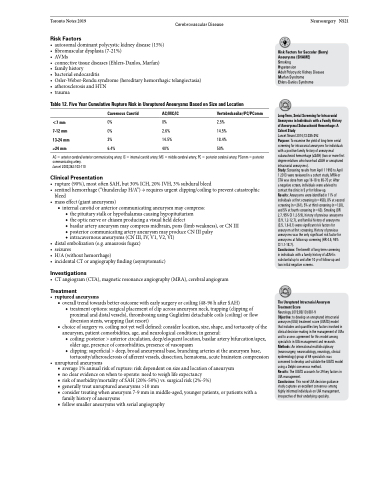Page 819 - TNFlipTest
P. 819
Toronto Notes 2019
Cerebrovascular Disease
Neurosurgery NS21
Risk Factors
• autosomaldominantpolycystickidneydisease(15%) • fibromusculardysplasia(7-21%)
• AVMs
• connectivetissuediseases(Ehlers-Danlos,Marfan)
• familyhistory
• bacterialendocarditis
• Osler-Weber-Rendusyndrome(hereditaryhemorrhagictelangiectasia) • atherosclerosisandHTN
• trauma
Table 12. Five Year Cumulative Rupture Risk in Unruptured Aneurysms Based on Size and Location
Risk Factors for Saccular (Berry) Aneurysms (SHAME)
Smoking
Hypetension
Adult Polycystic Kidney Disease Marfan Syndrome Ehlers-Danlos Syndrome
Long-Term, Serial Screening for Intracranial Aneurysms in Individuals with a Family History of Aneurysmal Subarachnoid Hemorrhage: A Cohort Study
Lancet Neurol 2014;13:385-392
Purpose: To examine the yield of long-term serial screening for intracranial aneurysms for individuals with a positive family history of aneurysmal subarachnoid hemorrhage (aSAH) (two or more first degree relatives who have had aSAH or unruptured intracranial aneurysms).
Study: Screening results from April 1 1993 to April 1 2013 were reviewed in a cohort study. MRA or CTA was done from age 16-18 to 65-70 yr. After
a negative screen, individuals were advised to contact the clinic in 5 yr for follow-up.
Results: Aneurysms were identified in 11% of individuals at first screening (n=458), 8% at second screening (n=261), 5% at third screening (n=128), and 5% at fourth screening (n=63). Smoking (OR 2.7, 95% CI 1.2-5.9), history of previous aneurysms (3.9, 1.2-12.7), and familial history of aneurysms (3.5, 1.6-8.1) were significant risk factors for aneurysm at first screening. History of previous aneurysms was the only significant risk factor for aneurysms at follow-up screening (HR 4.5, 95%
CI 1.1-18.7).
Conclusions: The benefit of long-term screening
in individuals with a family history of aSAH is substantial up to and after 10 yr of follow-up and two initial negative screens.
The Unruptured Intracranial Aneurysm Treatment Score
Neurology 2015;85(10):881-9
Objective: to develop an unruptured intracranial aneurysm (UIA) treatment score (UIATS) model that includes and quantifies key factors involved in clinical decision-making in the management of UIAs and to assess agreement for this model among specialists in UIA management and research. Methods: An international multidisciplinary (neurosurgery, neuroradiology, neurology, clinical epidemiology) group of 69 specialists was convened to develop and validate the UIATS model using a Delphi consensus method.
Results: The UIATS accounts for 29 key factors in UIA management.
Conclusions: This novel UIA decision guidance study captures an excellent consensus among highly informed individuals on UIA management, irrespective of their underlying specialty.
<7 mm 7-12 mm 13-24 mm ≥24 mm
Cavernous Carotid AC/MC/IC
0% 0% 0% 2.6% 3% 14.5% 6.4% 40%
Vertebrobasilar/PC/PComm
2.5% 14.5% 18.4% 50%
AC = anterior cerebral/anterior communicating artery; IC = internal carotid artery; MC = middle cerebral artery; PC = posterior cerebral artery; PComm = posterior communicating artery.
Lancet 2003;362:103-110
Clinical Presentation
• rupture(90%),mostoftenSAH,but30%ICH,20%IVH,3%subduralbleed
• sentinel hemorrhage (“thunderclap H/A”) → requires urgent clipping/coiling to prevent catastrophic
bleed
• masseffect(giantaneurysms)
■ internal carotid or anterior communicating aneurysm may compress:
◆ the pituitary stalk or hypothalamus causing hypopituitarism
◆ the optic nerve or chiasm producing a visual field defect
◆ basilar artery aneurysm may compress midbrain, pons (limb weakness), or CN III ◆ posterior communicating artery aneurysm may produce CN III palsy
◆ intracavernous aneurysms (CN III, IV, V1, V2, VI)
• distalembolization(e.g.amaurosisfugax)
• seizures
• H/A(withouthemorrhage)
• incidentalCTorangiographyfinding(asymptomatic)
Investigations
• CTangiogram(CTA),magneticresonanceangiography(MRA),cerebralangiogram
Treatment
• rupturedaneurysms
■ overall trend towards better outcome with early surgery or coiling (48-96 h after SAH)
◆ treatment options: surgical placement of clip across aneurysm neck, trapping (clipping of proximal and distal vessels), thrombosing using Guglielmi detachable coils (coiling) or flow diversion stents, wrapping (last resort)
■ choice of surgery vs. coiling not yet well defined: consider location, size, shape, and tortuosity of the aneurysm, patient comorbidities, age, and neurological condition; in general:
◆ coiling: posterior > anterior circulation, deep/eloquent location, basilar artery bifurcation/apex, older age, presence of comorbidities, presence of vasospasm
◆ clipping: superficial > deep, broad aneurysmal base, branching arteries at the aneurysm base, tortuosity/atherosclerosis of afferent vessels, dissection, hematoma, acute brainstem compression
• unrupturedaneurysms
■ average 1% annual risk of rupture: risk dependent on size and location of aneurysm
■ no clear evidence on when to operate: need to weigh life expectancy
■ risk of morbidity/mortality of SAH (20%-50%) vs. surgical risk (2%-5%)
■ generally treat unruptured aneurysms >10 mm
■ consider treating when aneurysm 7-9 mm in middle-aged, younger patients, or patients with a
family history of aneurysms
■ follow smaller aneurysms with serial angiography


